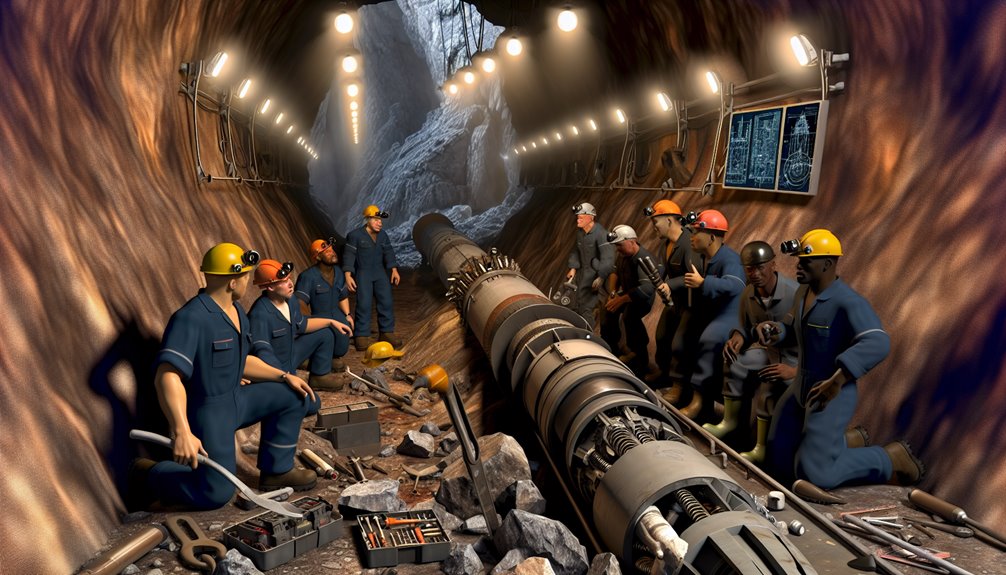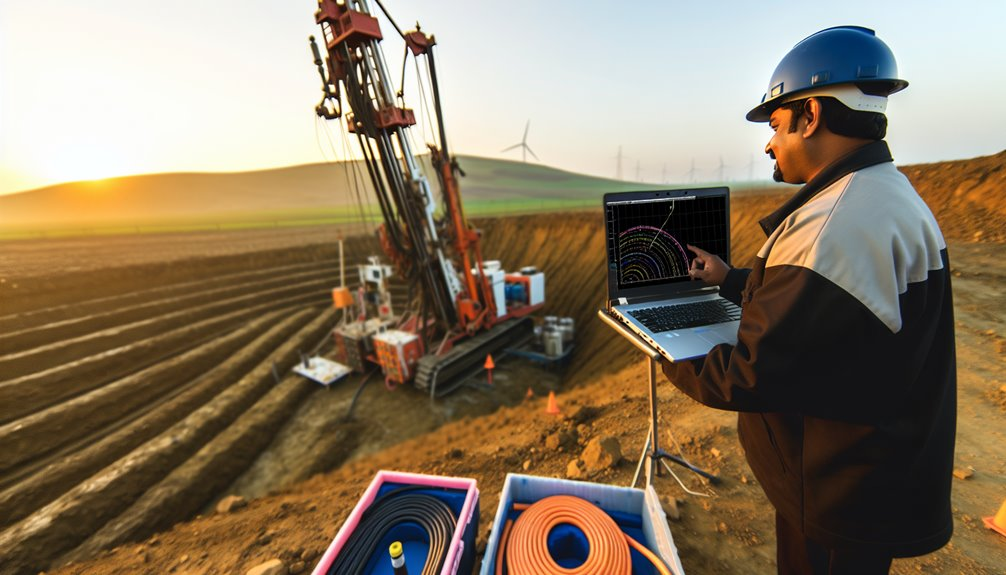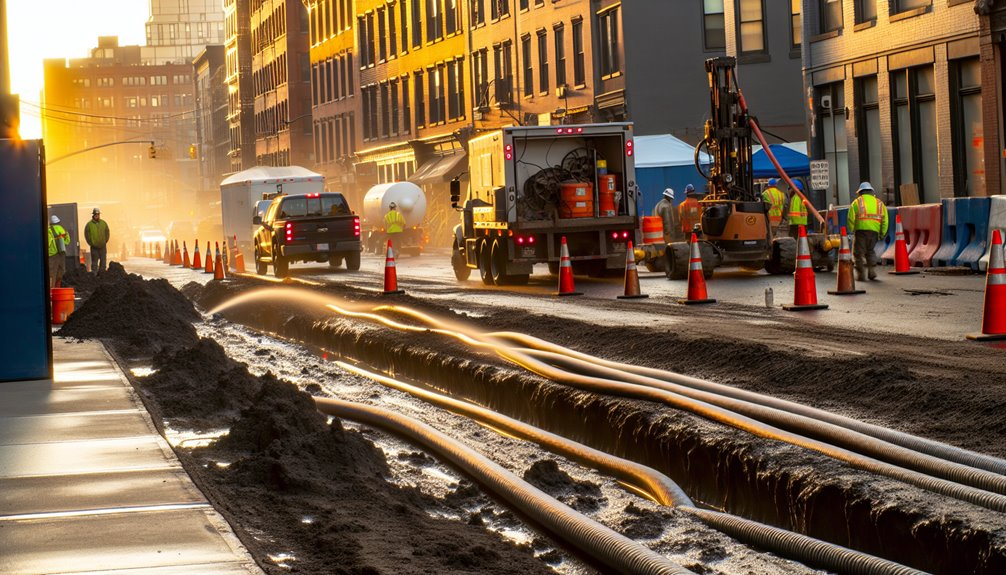As you commence missile boring projects, you'll frequently encounter variable geological conditions that can drastically affect your progress. To stay ahead, you'll need to integrate advanced mapping technologies and perform thorough geological surveys before commencing any drilling. This proactive approach not only minimizes surprises but also enhances your team's ability to adapt to unforeseen challenges. The next section will explore how maneuvering through stringent regulatory landscapes can further impact your project's timeline and overall success.
Identifying and Managing Geological Variabilities

Understanding and managing geological variabilities is essential when you're dealing with missile boring projects. Initiating thorough geological mapping and extensive soil testing is vital. These steps identify the diverse conditions you'll face, such as hard rock formations that increase the risk of borehole collapse, or clay soils that necessitate specialized drilling tools. Recognizing whether you're working in low or high blow count geology impacts your choice of tooling and techniques, ensuring alignment and bore quality. Incorporating this data into your project planning not only optimizes the boring process but also mitigates potential delays and cost overruns caused by unforeseen geological challenges. Accurate geological assessment enables more predictable and efficient project outcomes. Due to varying geological conditions, it is crucial to have adaptive strategies for tunneling under different terrains to maintain structural stability and ensure the safety of the operations (varying geological conditions).
Navigating Strict Regulatory Requirements
As you commence on missile boring projects, adhering to strict regulatory requirements is essential for both legal compliance and environmental protection.
You must implement drilling fluid management systems and erosion control measures to mitigate environmental impact. This includes ensuring that sensitive ecosystems, wetlands, and groundwater are protected by adhering to environmental regulations meticulously.
Accurate utility mapping and the use of advanced technologies such as GPR are imperative to avoid damaging underground utilities, thereby ensuring regulatory compliance.
Operator certification is critical; your team must be trained and licensed, understanding daily job safety and total job analyses.
Maintaining detailed documentation and regular updates of compliance records are mandatory.
To manage drilling fluid loss effectively, the introduction of advanced containment solutions is necessary, particularly in areas prone to seepage or where the soil composition is less stable.
This proactive approach helps manage potential regulatory challenges efficiently, keeping your projects compliant and on schedule.
Dealing With Equipment Malfunction and Maintenance
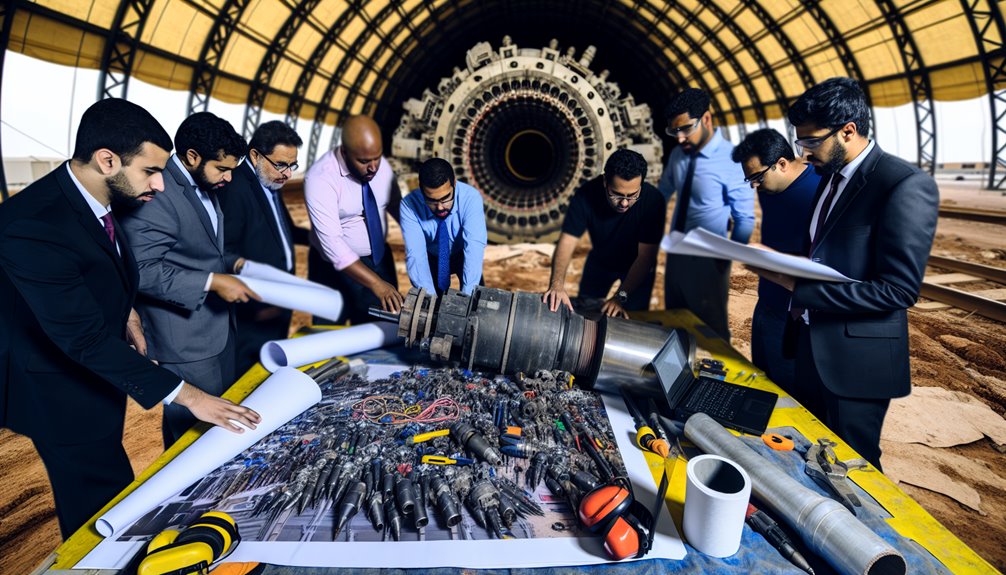
As you navigate the complexities of missile boring operations, adopting preventative maintenance strategies is essential to mitigate regular wear and tear and operator-induced errors.
You'll need a rapid malfunction response plan to address unexpected breakdowns efficiently, ensuring minimal downtime and sustained operational safety.
Preventative Maintenance Strategies
To guarantee the longevity and efficiency of missile boring equipment, it's critical to adopt preventative maintenance strategies that address potential equipment malfunctions and maintenance challenges.
Here are four essential steps you can take:
- Research Ground Conditions: Before starting, assess soil types to select the right equipment and modify maintenance planning accordingly, preventing undue wear.
- Regular Component Checks: Inspect air hoses, couplers, and seals routinely. Implementing regular visual and functional checks minimizes the risk of unexpected failures.
- Follow Manufacturer Guidelines: Adhere to the recommended maintenance schedules. Use predictive maintenance tools to forecast potential issues, enhancing preventative strategies.
- Consider Environmental Impacts: Adjust maintenance frequency based on operating environments. Harsher conditions demand more rigorous checks and balance.
Rapid Malfunction Response
When equipment failures occur, rapid malfunction response becomes critical to minimizing downtime and maintaining operational efficiency. You must prioritize malfunction analysis to pinpoint the root causes, integrating historical data with real-time monitoring of variables like vibration and temperature.
Implement predictive maintenance strategies that utilize data analysis to foresee potential breakdowns, allowing preemptive action.
Develop thorough response protocols that include regular emergency drills and scenario-based training for your team, ensuring everyone is adept at using the equipment correctly and efficiently during crises.
Maintain a well-stocked inventory of critical spare parts to replace faulty components swiftly, avoiding prolonged operational halts.
Enhancing Equipment Reliability
Enhancing equipment reliability requires addressing both design flaws and maintenance practices, as these factors critically influence the operational lifespan and effectiveness of missile systems.
Here's how you can boost your system's reliability:
- Redesign Critical Components: Address design reliability by modifying components prone to failure, such as turbine discs and electronics, to withstand environmental stressors.
- Implement Advanced Monitoring Technologies: Utilize MEMS and SMART technologies to continuously monitor and evaluate the operational conditions, guaranteeing timely maintenance interventions.
- Standardize Maintenance Protocols: Develop and adhere to thorough maintenance strategies that include regular, preventive maintenance and detailed record-keeping.
- Invest in Training: Guarantee all maintenance personnel are well-trained in the latest diagnostic and repair techniques to maintain high standards of operation and care.
Ensuring Accuracy in Guidance Systems
Although missile guidance systems are designed for precision, ensuring their accuracy remains a formidable challenge due to several inherent limitations and external factors.
You'll encounter inertial guidance limitations that accumulate errors over time. To combat this, integrate periodic corrections from external references like GPS to enhance reliability.
External interferences, such as electronic countermeasures and environmental anomalies, also disrupt accuracy. Implementing robust cybersecurity measures and advanced error-correcting algorithms can shield against these threats.
Moreover, the complexity of target tracking demands continuous refinement of your guidance algorithms to handle maneuvering targets and mitigate issues like target glint.
Emphasizing improvements in your systems' algorithmic challenges and kinematic capabilities will greatly elevate their operational effectiveness and accuracy.
Handling Environmental Impact and Sustainability Concerns
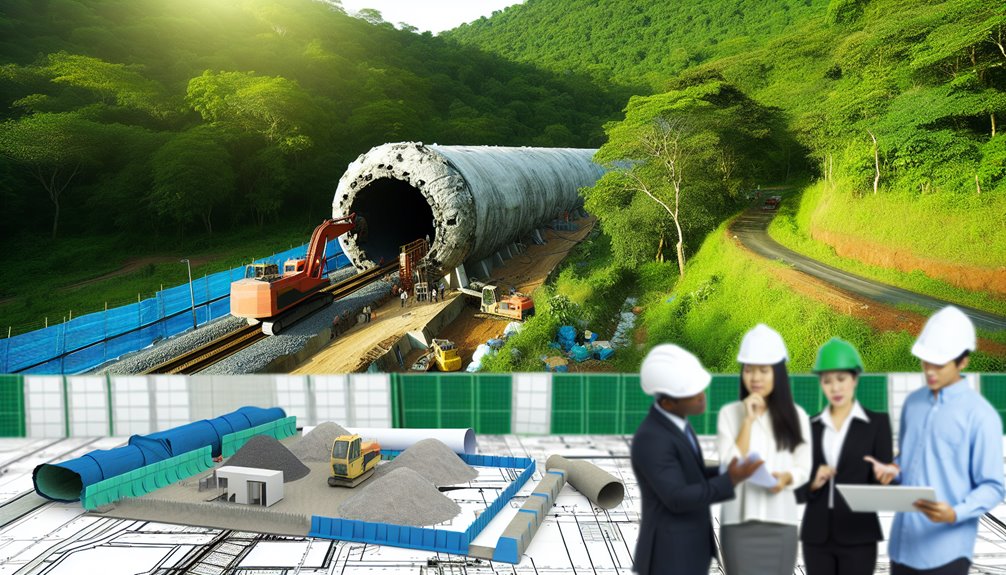
As you tackle environmental impact and sustainability concerns in missile boring operations, prioritizing minimal surface disturbance is essential. Here are four key actions to contemplate:
- Conduct Environmental Assessments: Initiate thorough environmental assessments to identify and mitigate risks to sensitive ecosystems and adhere to regulatory standards.
- Manage Drilling Fluids Efficiently: Implement effective drilling fluid management systems and guarantee proper disposal techniques to prevent environmental contamination.
- Adopt Erosion and Spill Controls: Utilize erosion control measures and spill containment solutions to protect water bodies and wetlands.
- Minimize Energy Use: Opt for sustainable practices that reduce energy consumption and emissions, such as using advanced technology that requires fewer resources.
These steps will help you address sustainability while maintaining operational efficiency.
Coping With Unexpected Underwater Obstacles
As you shift to projects that may inadvertently encounter underwater environments, it's essential you're prepared to identify underwater hazards swiftly.
You'll need to employ advanced navigation techniques to accurately detect and map these obstacles, ensuring your path is clear.
Additionally, developing effective obstacle removal strategies will be important to maintain the progress and safety of your boring operations.
Identifying Underwater Hazards
When tackling underwater missile boring projects, you must first accurately identify potential hazards that could disrupt operations. Effective underwater inspections and precise hazard identification are pivotal.
Here are key steps to enhance your strategy:
- Geological Analysis: Evaluate local geology thoroughly to understand the distribution of rock and soil types like coquina, coral, or clay.
- Utility Mapping: Utilize ground-penetrating radar and electromagnetic tools to detect and map existing utilities, preventing costly damages.
- Environmental Protection: Implement drilling fluid management and erosion control to comply with environmental regulations.
- Logistical Planning: Address physical and logistical limitations by selecting appropriate equipment and planning for compact or limited access sites.
These steps will guarantee you're well-prepared to manage underwater challenges effectively.
Advanced Navigation Techniques
After mastering the identification of underwater hazards, you'll find that traversing these environments presents its own set of complex challenges.
Employ advanced sonar mapping techniques to navigate through high clutter density and turbid waters. This technology not only enhances visibility but also helps in maintaining the accuracy of sensor data amidst varying water densities and currents.
Incorporate autonomous navigation systems in your AUVs to guarantee they can operate effectively without real-time operator control.
Pre-program these vehicles to follow designated waypoints, enabling them to handle "dull, dirty, and dangerous" tasks with minimal human intervention. This method reduces the need for continuous operator input and mitigates the risks associated with limited communication capabilities.
Obstacle Removal Strategies
While you navigate through your missile boring project, encountering unexpected underwater obstacles requires a strategic approach to keep your operations efficient.
Here are key strategies to effectively handle these challenges:
- Implement Advanced Obstruction Detection Techniques: Utilize ground-penetrating radar and sonar systems to identify hidden obstacles early in the boring process.
- Employ Soil Stabilization Methods: Integrate chemical or mechanical stabilization to enhance soil integrity and prevent collapse around obstructions.
- Adapt Boring Equipment: Customize or upgrade your boring tools to handle specific soil conditions and underground barriers effectively.
- Continuous Monitoring: Rigorously monitor boring progress using real-time data to make swift adjustments in response to emerging obstacles.
These proactive steps guarantee your project remains on track despite unexpected challenges.
Optimizing Resource Allocation and Cost Management
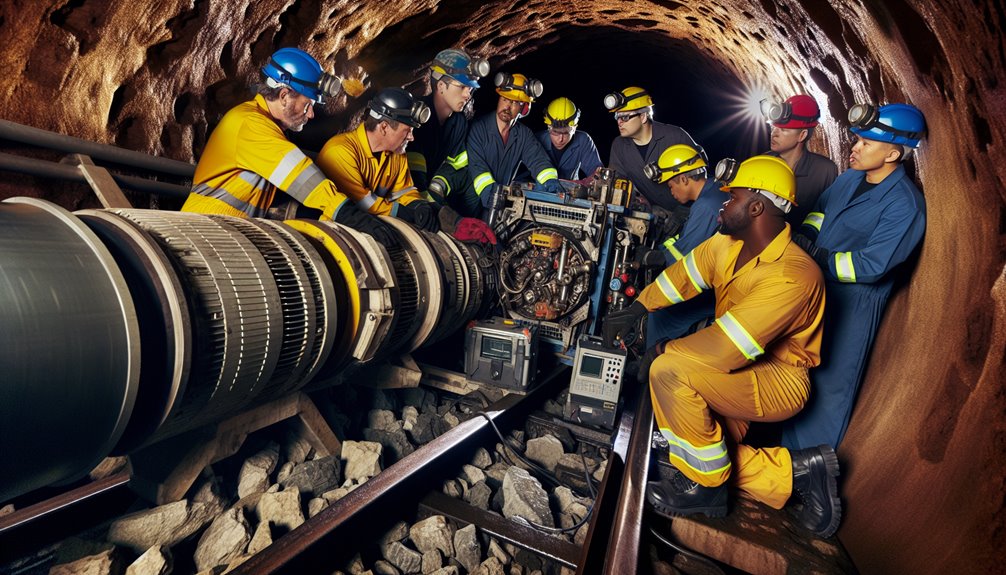
To effectively manage your missile boring projects, it's critical to optimize resource allocation and cost management. You'll face resource constraints and underutilization, often exacerbated by specialized roles in short supply. Monitoring resource utilization throughout the project helps pinpoint underutilized resources.
Regularly reallocating tasks can even out workload, optimizing resource use and project predictability. Implementing resource management tools provides live insights, essential for managing shared resources effectively across multiple projects.
Also, accurate forecasting of resource needs prevents underutilization or overutilization, important for cost-effective planning. Remember, preventive maintenance on equipment minimizes failures, reducing unexpected costs.
Finally, always include environmental and regulatory costs in your budgeting to avoid surprises and guarantee compliance.
Maintaining Crew Safety in Hazardous Conditions
Guaranteeing the safety of your crew in hazardous conditions is paramount for any missile boring project. Here's how you can maintain a safe environment:
- Implement Extensive Crew Training: Conduct regular sessions on Job Hazard Analysis and safety procedures, including specialized training for hazard communication and emergency response.
- Regular Safety Audits and JSAs: Enforce daily reviews of Job Safety Analyses and frequent safety audits to anticipate and mitigate risks effectively.
- Strict Compliance and Monitoring: Uphold a zero-tolerance policy towards drugs and guarantee all safety protocols are strictly followed, with supervisors held accountable for their crew's safety records.
- Effective Hazard Communication: Maintain clear, ongoing communication about potential risks and safety updates to keep everyone informed and prepared.
Addressing Noise and Vibration Issues

After addressing crew safety, it's equally important to focus on managing noise and vibration during missile boring operations. Identifying the sources is your first step.
You'll find that variations in soil types, from rock to sand, greatly influence noise levels and vibration intensities. Utilizing specialized drilling tools and adjusting drilling mud properties can mitigate these effects. Regular maintenance and adherence to manufacturer guidelines are essential to minimize equipment-related disturbances.
Implement sound absorbers in areas sensitive to structural noise to achieve further noise reduction.
Implementing Advanced Technology and Training
As missile boring contractors incorporate advanced technologies and training, they considerably enhance operational precision and safety.
Here's how you can leverage these advancements:
- Ground Penetrating Radar (GPR) and Electromagnetic Locators: Utilize these for precise utility mapping, minimizing the risk of striking existing infrastructures and reducing environmental impact.
- Advanced Drilling Fluid Management Systems: Select the right fluid properties to guarantee cooling, lubrication, and stability of the drill bit, preventing site damage.
- Steering Technologies: Employ these for exact utility installation paths, enabling operations under complex conditions like urban environments or across obstacles.
- Comprehensive Safety Training Programs: Implement these to guarantee compliance with safety regulations, covering everything from CPR to Hazard Communications and damage prevention.
Conclusion
As a missile boring contractor, you'll need to navigate complex challenges effectively. Guarantee you conduct detailed geological assessments and utilize advanced mapping to manage terrain variabilities. Adhere strictly to safety and environmental regulations to maintain compliance and minimize impact. Implement regular equipment maintenance to prevent malfunctions and optimize your resource allocation for cost efficiency. By integrating advanced technology and continuous crew training, you can enhance the precision of your operations and guarantee the safety and success of your projects.
If you're looking to dive deeper into the world of missile boring and discover how we can help you overcome these challenges, I invite you to visit Boring Bros at boringbro.com. You can also give us a call at (954) 639-6167. We're here to answer your questions and support your projects with a friendly touch!

